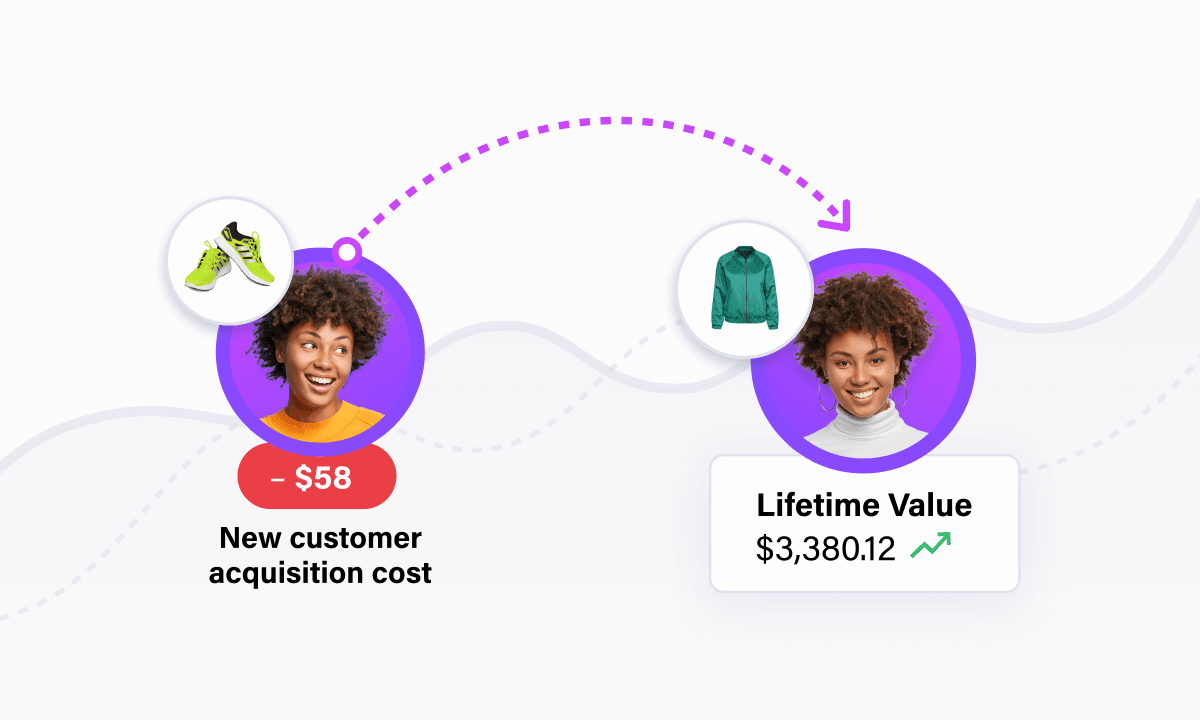Customer lifetime value (LTV or CLV) is a crucial metric that measures the total value a customer brings to a business over the course of their lifetime. In eCommerce, LTV plays a crucial role in determining the health and success of a business. The higher the LTV, the more profitable and sustainable the business will be.
In this page, we’ll dive into the basics of LTV, explain how to calculate it, and provide practical tips on how to increase it. Whether you’re just starting out or looking to optimize your eCommerce strategy, this page will provide valuable insights on how to measure and improve your LTV. Let’s get started!
Understanding the Basics of LTV
The basics of customer lifetime value (LTV) involve understanding what it measures and the common metrics and formulas used to calculate it.
LTV calculates the total revenue a customer is expected to generate for a business over their lifetime as a customer. The most common LTV formula takes into account:
- The average purchase value
- The frequency of purchases
- The average customer lifespan
LTV = Average Purchase Value x Purchase Frequency x Average Customer Lifespan.
This formula considers the average amount a customer spends per transaction, how frequently they make purchases, and the average length of time they remain a customer.
For example, an eCommerce business has an average purchase value of $50, an average customer lifespan of 3 years, and an average purchase frequency of 4 times per year. Using the first formula, the LTV would be calculated as $50 x 4 x 3 = $600. This means that on average, a customer is expected to generate $600 in revenue for the business over their lifetime.
It is important to have a good understanding of the basics of LTV as it provides a clear picture of the value a customer brings to the business which can inform key business decisions.
Why Is Customer Lifetime Value So Important?

LTV provides insight into the cost-effectiveness of your customer acquisition, the value of customer retention, and the potential for future revenue.
Here are the top reasons why you should pay attention to customer lifetime value:
Customer Acquisition Cost
LTV provides insight into the cost-effectiveness of customer acquisition efforts, allowing your business to optimize marketing and sales strategies to acquire high-value customers.
Customer Retention
A high LTV indicates that a business has a loyal customer base, allowing your business to prioritize efforts to retain and engage those customers.
Resource Allocation
LTV helps you allocate resources effectively by identifying the most valuable customers and focusing efforts on retaining and engaging them.
Sales Forecasting
LTV provides insight into future revenue by projecting the expected revenue from each customer over their lifetime, allowing you to make informed decisions about sales forecasting and budgeting.
Customer Segmentation
LTV allows you to segment your customer base and tailor your marketing and retention efforts to each customer segment, improving customer engagement and loyalty.
Product Development
Understanding the LTV of different customer segments and product lines can inform your business product development strategies and help it to focus on high-value products and customers.
Long-Term Planning
LTV provides a long-term perspective on the value of your customer base, allowing you to make informed decisions about growth and sustainability.
Interpreting LTV Results & Identifying Opportunities for Improvement
There are a few ways you can interpret your customer lifetime value results which involves analyzing the data to identify trends and opportunities for improvement.
High LTV indicates a loyal customer base and the potential for future revenue, while low LTV may signal the need for improved customer acquisition and retention strategies.
It’s worthwhile taking a look at factors such as your average purchase value, purchase frequency, and customer lifespan, where you can then begin to identify areas where you can optimize your efforts to increase LTV and improve overall customer value.
Opportunities for improvement may include:
- Targeted marketing campaigns
- Improved product offerings
- Enhanced customer service efforts
- Offering loyalty programs and incentives
Targeted Marketing Campaigns
By understanding the behaviour, preferences, and needs of your customers, you can create marketing campaigns that resonate with your target audience and drive customer engagement.
Targeted marketing campaigns can take many forms, including email marketing, social media advertising, and personalized product recommendations.
Here is how you can create your own targeted marketing campaign:
- Customer Segmentation: Start by segmenting your customer base into groups based on demographic, behavioural, and psychographic characteristics.
- Identify High-Value Customers: Analyze your customer data to identify those customers who are most valuable to your business, in terms of frequency of purchases, average order value, and overall lifetime value.
- Develop Campaign: Based on the insights gained from customer segmentation and analysis, develop a targeted marketing campaign aimed at the identified high-value customers. This campaign could include targeted email marketing, personalized product recommendations, or exclusive promotions and discounts.
- Offer Incentives: Provide incentives to encourage customers to engage with the campaign and make a purchase. This could include a discount on their next purchase or a free gift with the purchase.
- Measure Success: Monitor the results of the campaign and use data analysis to measure its impact on attribution, customer engagement, repeat purchases, and overall LTV.
By using data-driven insights and targeting the right customers with the right message, you can improve the effectiveness of your marketing campaigns and drive customer loyalty.
Improved Product Offerings
By constantly improving and updating your product offerings, you can meet the evolving needs and preferences of your customers. This can be achieved through a variety of methods, such as conducting market research, testing new products, and soliciting customer feedback.
By offering high-quality and innovative products, you can differentiate your business from your competitors, drive customer satisfaction, and ultimately, increase customer loyalty. Satisfied customers are more likely to make repeat purchases and remain loyal over time, leading to a high LTV.
Enhanced Customer Service Efforts

56% of worldwide consumers say customer service is “very important” in brand choice and loyalty.
By providing responsive, helpful, and personalized customer service, your business can build strong relationships with your customers and drive customer satisfaction.
This can be achieved through a variety of methods, such as offering multiple channels of customer support such as email and chat, providing prompt resolution of customer issues, and proactively addressing customer needs.
By investing in your customer service, you can dramatically improve the customer experience, increase customer loyalty, and ultimately, drive a high customer lifetime value.
Offering Loyalty Programs and Incentives
These types of programs encourage customers to return to your business and make repeat purchases, improving customer retention and driving long-term revenue.
By offering rewards, discounts, and other benefits, you can incentivize customer loyalty and foster a sense of community among their customer base.
Here are a few examples:
- Points-based program: Your business could offer a loyalty program where customers earn points for each purchase they make. These points can then be redeemed for discounts or special offers on future purchases.
- VIP perks: The loyalty program could also include special perks for customers who reach certain spending thresholds, such as free shipping, exclusive product offerings, or early access to sales.
- Personalized experiences: Your business could use customer data to create personalized experiences for loyalty program members, such as tailored product recommendations or special promotions based on their buying habits.
- Engagement opportunities: The loyalty program could also provide opportunities for customers to engage with the brand through events, online communities, or social media.
Loyalty programs can help your business gather valuable customer data and insights, allowing you to better understand your customers and create more targeted marketing campaigns.
Related: 10 Ways To Increase Customer Loyalty
Cross-Selling and Upselling Effectively
Offering related or complementary products to customers during their purchase journey, can help your business increase the average order value and furthermore drive customer loyalty.
Cross-selling involves suggesting complementary products, while upselling involves suggesting a higher-end or a premium version of your product.
Both strategies are effective in driving customer satisfaction and increasing customer loyalty, as satisfied customers are more likely to make repeat purchases knowing you provide a range of products or premium products where it may meet their needs even more so.
Measuring the Impact of LTV-Increasing Strategies
Measuring the impact of LTV-increasing strategies is crucial for your business to understand the effectiveness of your efforts so that you can make informed decisions for future growth. The following methods can be used to measure the impact of these strategies:
- Customer Retention Rate: Measuring the percentage of customers who make repeat purchases can provide insight into the effectiveness of customer loyalty programs and customer service efforts.
- Average Order Value (AOV): Tracking changes in AOV over time can help you understand the impact of your cross-selling and upselling efforts.
- Gross Margin: Measuring gross margin can provide insight into the profitability of the business and the effectiveness of product offerings and pricing strategies.
- Net Promoter Score (NPS): NPS is a metric that measures customer satisfaction and can provide insight into the impact of customer experience efforts.
- Customer Acquisition Cost (CAC): Measuring changes in CAC over time can help you understand the impact of targeted marketing campaigns and the cost-effectiveness of customer acquisition efforts.
By regularly tracking these metrics and analyzing the results, you can identify areas for improvement and make data-driven decisions to drive a high LTV. Additionally, A/B testing can be used to measure the impact of specific strategies and make informed decisions for future growth.
Conclusion
To recap, when calculating and aiming to increase customer lifetime value (LTV) within your business, you need to consider several key strategies and metrics. To calculate LTV, you can use the very simple formula, which is the average revenue per customer multiplied by the number of customer transactions.
To increase customer lifetime value, your business should focus on improving the customer experience for the potential buyer, create targeted marketing campaigns that deliver the right message to your audience, provide loyalty programs and incentives to maintain customer loyalty and retention whilst aiming to enhance customer service efforts.
By measuring the impact of these efforts through the metrics discussed, you can make data-driven decisions and drive long-term revenue growth. Following these strategies, you will have the ability to drive a high customer lifetime value and achieve sustainable growth over time.
Maximize growth and customer loyalty by using eDesk’s proactive messaging, review management, and insightful analytics to enhance your lifetime value (LTV).

